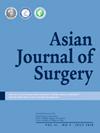Balancing precision and quality of life: Comparing systematic lymph node dissection and sampling in early-stage NSCLC through patient-reported outcomes
IF 3.8
3区 医学
Q1 SURGERY
引用次数: 0
Abstract
Background
The increased detection of early-stage non-small cell lung cancer (NSCLC) has led to a discussion of optimal lymph node management modalities, particularly between systematic lymph node dissection (SLND) and lymph node sampling (LNS). The aim of this study was to compare early postoperative patient-reported outcomes (PROs) and short-term clinical outcomes of SLND and LNS.
Methods
A total of 394 patients with early-stage NSCLC were enrolled between December 2021 and December 2023. Patients were divided into SLND (n = 266) and LNS (n = 128) groups. Early postoperative symptoms, functional burdens and short-term clinical outcomes were compared between the two groups. Statistical analyses were performed using mixed-effects models and Kaplan-Meier analysis.
Results
Patients in the SLND group voluntarily reported more severe coughing in the early postoperative period (P = 0.046). The proportion of patients with moderate-to-severe coughing was significantly higher in the SLND group in the postoperative period of 1–4 days (P < 0.001). At 1–4 weeks post-discharge, the SLND group had a higher proportion of patients with moderate-to-severe pain (p = 0.009), shortness of breath (p = 0.001), disturbed sleep (p = 0.018), fatigue (p = 0.004) and distress (p = 0.002). In terms of short-term clinical outcomes, the operative times (P < 0.001), postoperative drainage time (P < 0.001), and postoperative hospital stays (P < 0.001) were significantly longer in the SLND group than in the LNS group.
Conclusion
SLND is associated with more severe symptoms, functional burden, and short-term clinical outcomes than LNS. LNS may be a more suitable surgical approach for early-stage NSCLC patients deemed lymph node-negative, optimizing both cancer management and postoperative quality of life.
平衡精确性和生活质量:通过患者报告的结果比较早期NSCLC的系统性淋巴结清扫和采样
背景:随着早期非小细胞肺癌(NSCLC)的发现越来越多,人们开始讨论最佳的淋巴结管理方式,特别是在系统性淋巴结清扫(SLND)和淋巴结取样(LNS)之间。本研究的目的是比较SLND和LNS的术后早期患者报告的预后(PROs)和短期临床预后。方法在2021年12月至2023年12月期间,共有394例早期NSCLC患者入组。患者分为SLND组(n = 266)和LNS组(n = 128)。比较两组患者术后早期症状、功能负担及近期临床结果。采用混合效应模型和Kaplan-Meier分析进行统计分析。结果SLND组患者术后早期自觉咳嗽加重(P = 0.046)。SLND组患者术后1 ~ 4天出现中重度咳嗽的比例明显高于SLND组(P < 0.001)。在出院后1-4周,SLND组出现中重度疼痛(p = 0.009)、呼吸短促(p = 0.001)、睡眠不安(p = 0.018)、疲劳(p = 0.004)和窘迫(p = 0.002)的患者比例更高。短期临床结果方面,SLND组的手术次数(P < 0.001)、术后引流时间(P < 0.001)、术后住院时间(P < 0.001)均明显长于LNS组。结论slnd比LNS有更严重的症状、功能负担和短期临床结果。对于淋巴结阴性的早期NSCLC患者,LNS可能是一种更合适的手术入路,可以优化癌症管理和术后生活质量。
本文章由计算机程序翻译,如有差异,请以英文原文为准。
求助全文
约1分钟内获得全文
求助全文
来源期刊

Asian Journal of Surgery
医学-外科
CiteScore
3.60
自引率
31.40%
发文量
1589
审稿时长
33 days
期刊介绍:
Asian Journal of Surgery, launched in 1978, is the official peer-reviewed open access journal of the Asian Surgical Association, the Taiwan Robotic Surgery Association, and the Taiwan Society of Coloproctology. The Journal is published monthly by Elsevier and is indexed in SCIE, Medline, ScienceDirect, Scopus, Embase, Current Contents, PubMed, Current Abstracts, BioEngineering Abstracts, SIIC Data Bases, CAB Abstracts, and CAB Health.
ASJSUR has a growing reputation as an important medium for the dissemination of cutting-edge developments in surgery and its related disciplines in the Asia-Pacific region and beyond. Studies on state-of-the-art surgical innovations across the entire spectrum of clinical and experimental surgery are particularly welcome.
The journal publishes original articles, review articles, and case reports that are of exceptional and unique importance. The journal publishes original articles, review articles, and case reports that are of exceptional and unique importance.
 求助内容:
求助内容: 应助结果提醒方式:
应助结果提醒方式:


